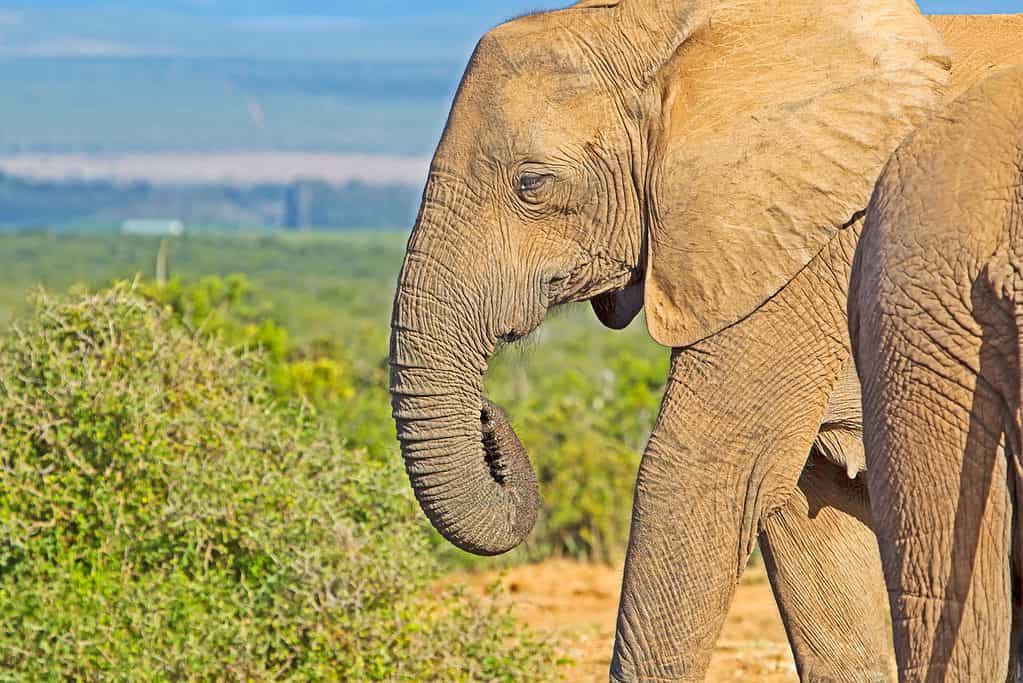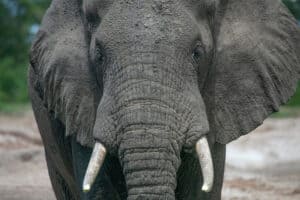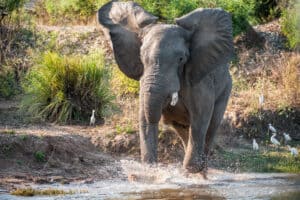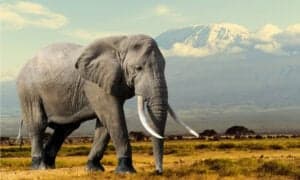Elephants are one of the most famous animals worldwide, despite occurring naturally in only two continents. Many idioms and cultural references are made about the elephant’s trunks, heavy limbs, enormous size, and tusks. But would you believe that not all elephants have tusks?
Tuskless elephants exist, and their numbers grow with each new generation of elephants. Why do certain elephants not have tusks? Are all tuskless elephants females? Keep reading to find out.
Elephant Tusks: What Are They?
Tusks are continuously growing elephant teeth. Unlike wild boars and walruses, elephant tusks are not extended canines but incisors. Elephant teeth comprise 12 molars, 12 premolars, and two tusks. This dentition is due to the animal’s herbivorous diet.
The outermost layer of an elephant’s tusk is made up of enamel, the hardest substance in the human body. Beneath the enamel is dentin and then cementum which keeps the tusk in place. The tusk’s core is the pulp, which consists of nerve endings, connective tissue, and blood vessels.
According to the San Diego Wildlife Alliance Library, permanent tusks are always in place at the age of two in young elephants, replacing baby tusks that fall off about 12 months after birth. Tusks grow about seven inches per year, and since they continuously grow, they can, therefore, be used to determine an elephant’s age.
Asian elephants have straighter and slimmer tusks than African elephants, reaching over six feet. According to the Guinness World Records, the longest tusk worldwide measured over 11 feet, longer than the tallest human ever.
What Are the Purposes of Tusks to Elephants?

Elephants can use their tusks to defend themselves against other elephants,
©Ondrej Prosicky/Shutterstock.com
While tusks are elephant teeth, they look like horns, and elephants know this as well, using them to defend themselves. Elephants are the largest terrestrial animals worldwide and do not have natural predators besides humans. Fights sometimes erupt between adult males to assert dominance and ward off competition for viable females during periods of heightened testosterone. Bulls of similar sizes lock horns and drive one another back in this tussle, which can sometimes be fatal.
However, elephants do not find humans threatening and are not known to attack humans with their giant tusks. Other purposes that tusks serve to elephants are the following:
- Protection and rests for their trunks
- Digging for salt, rocks, and water underground
- Debarking trees such as baobab, etc.
- Moving tree branches
- Lifting objects
What Elephants Are Tuskless?
A proportion of African bull and cow elephants are born with tusks. However, over the years, there has been an increase in the number of tuskless females on the continent. In Asia, all female elephants are tuskless, while the male population has a high percentage of tusked individuals.
Why Do Certain Elephants Not Have Tusks?

Some elephants are tuskless because of a genetic mutation triggered by poaching.
©iStock.com/geoffsp
According to a study, there was a 90% decline in the elephant population in Gorongosa National Park due to heavy poaching in Mozambique. As the elephant population began to recover, it was observed that many females were born tuskless. This was believed to be a genetic mutation triggered as a response to poaching, which allowed more female elephants to survive the genetic trait of tusklessness.
Based on account of the BBC, this mutation is sex-linked. This is why there have always been a few tuskless elephants within a herd. Female elephants have never needed tusks. However, tusklessness can be quite dangerous for males as they often defend themselves with these large incisors. It is believed that male offspring with these genes won’t survive in the womb. Thus, there are no tuskless African male elephants.
Furthermore, according to the African Wildlife Foundation, as the poaching of elephants with large tusks increases, so does the rise in the birth of more tuskless elephants. This means that these elephants with large tusks cannot pass on their genes to the next generation, which will adversely affect the population of elephants.
The same impact is being had on Asian elephants as well. According to Smithsonian National Zoo & Conservation Biology Institute, less than 10% of male Sri Lankan elephants have tusks. However, that number is higher in India, with up to 90% of the Indian elephant male population having tusks. Tuskless male elephants in Asia are referred to as “makhnas.”
Mini Tusks: What Are Tushes?
According to reports, tushes are smaller tusk-like teeth common among Asian elephants, with about 50% having them. Tushes are brittle and made up of different compositions, as compared to tusks. These smaller tusks often have a maximum length of two inches, while tusks can reach over nine feet.
Tushes have been known to grow back if their roots are not damaged. However, the growth is often insignificant.
Do Elephants Regrow Their Tusks?

Elephants do not regrow their tusks.
©Volodymyr Burdiak/Shutterstock.com
Elephants and rhinos are two of the strongest terrestrial animals, yet they both suffer poaching for their “horns.” However, according to scientific reports, while rhino horns might regrow after damage, elephant tusks do not. This is because rhino horns are made of the same composition as human hair and fingernails: keratin. The similarity between hair and fingernails is that they grow after being cut.
On the other hand, elephant tusks do not regrow after being removed because they are embedded inside the elephant’s skull and have a nerve running down its middle. Upon cutting the tusks and exposing these nerve endings, they can get infected and become fatal for the animal. Thus, the only feasible way to harvest tusks from elephants is to kill them or take them off a dead elephant. An elephant’s tusk will keep growing throughout its lifespan, but it will stop growth if damaged.
Up Next:
Do Female Elephants Have Tusks?
What Is the World’s Largest Elephant?
Elephant Tusks: What Are They Made of & What’s Their Purpose?
Mammoth vs Elephant: What’s the Difference?
Do Elephants Have Teeth? Their Dentition and Tusks Explained
The photo featured at the top of this post is © iStock.com/geoffsp
Sources
- JV Chamary, Available here: https://www.sciencefocus.com/news/has-ivory-poaching-triggered-the-evolution-of-tuskless-elephants/
- Laura Geggel, Available here: https://www.livescience.com/65117-do-elephant-tusks-or-rhino-horns-regrow.html
- , Available here: https://www.science.org/doi/10.1126/science.abe7389
- , Available here: https://www.awf.org/blog/going-tuskless
Thank you for reading! Have some feedback for us? Contact the AZ Animals editorial team.






